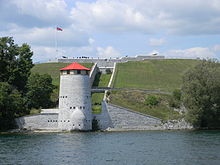Fort Henry, Ontario
 |
|
| Established | First fort: 1813, Second fort: 1836 |
|---|---|
| Location | Kingston, Ontario, Canada |
| Website | http://www.forthenry.com |
| Designated | 1923 |
Fort Henry (also known as Fort Henry National Historic Site) is located in Kingston, Ontario, Canada on Point Henry, a strategic, elevated point near the mouth of the Cataraqui River where it flows into the St. Lawrence River at the east end of Lake Ontario.
The original fort was constructed during the War of 1812 to protect the Kingston Royal Naval Dockyard (the site of the present-day Royal Military College of Canada) on Point Frederick from a possible American attack during the war and to monitor maritime traffic on the St. Lawrence River and Lake Ontario. The original fort was replaced by a much larger construction in the 1830s to maintain protection of the naval dockyard and protect the southern entrance to the Rideau Canal. The fort was restored in the 1930s and is a significant tourist attraction.
Although the first fort on Point Henry was built during the War of 1812, the construction of a fort was first suggested for this location much earlier. In the years immediately following the American Revolution, British-American hostilities still concerned the British. The British military established a post in what is now Kingston in 1783 by partly refurbishing and garrisoning the ruined French fort (Fort Frontenac). The garrison and the developing townsite near the fort were deemed difficult to defend and so a fortification was proposed for Point Henry by Captain John Ross, the British officer in charge of settling Loyalist refugees in what is now the Kingston area. This fort, however, was never built
At the beginning of the War of 1812, local militia erected a blockhouse and battery on Point Henry to defend the important naval base on Point Frederick, located across Haldimand Cove (now Navy Bay) to the west, and to monitor maritime traffic on the St. Lawrence River and Lake Ontario. On November 10, 1812, this battery was involved in repelling several American warships that were attacking the Provincial Marine sloop Royal George as the ship was taking refuge in Kingston Harbour. This naval action strengthened the view that a stronger fortification was needed and so the militia and regular army began building a more permanent fortification in 1813. The fort and the point on which the fort was built were named after Henry Hamilton, former Lieutenant-Governor of the Province of Quebec. The fort was one of several defensive structures built in and around Kingston during the war.
...
Wikipedia
